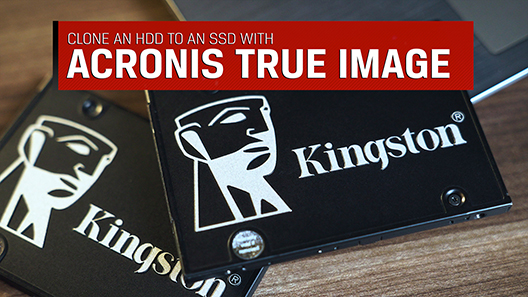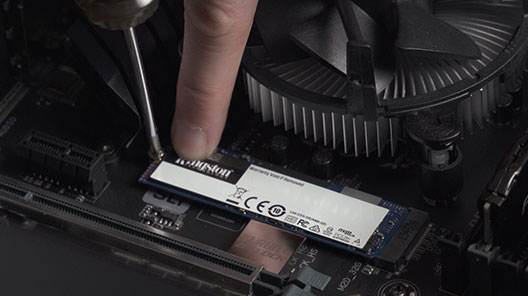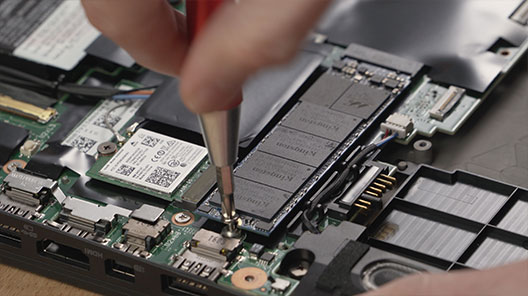
KC3000 PCIe 4.0 NVMe M.2 SSD -지원
리소스
동영상
FAQ(자주 묻는 질문)
1. https://www.kingston.com/support/technical/ssdmanager 에서 Kingston SSD Manager를 다운로드하여 귀하의 드라이브에 사용 가능한 펌웨어 업데이트가 있는지 확인하고, 있는 경우 업데이트를 적용합니다(권장되는 경우).
2. 시스템 제조업체의 지원 페이지를 참조하여 시스템에 사용할 수 있는 BIOS 업데이트가 있는지 확인하십시오.
3. 최신 버전의 운영 체제를 실행 중인지 확인하고 보류 중인 업데이트가 없는지 확인합니다.
4. 사용 중인 시스템의 최신 드라이버를 실행하고 있는지 확인하십시오. 시스템 제조업체의 지원 페이지를 방문하여 최신 드라이버 업데이트를 찾아볼 수 있습니다.
이 단계를 수행한 후에도 시스템에서 문제가 계속 발생하면 Kingston 기술 지원 부서에 문의하십시오.
FAQ: KSD-012010-001-21
이 조치가 도움이 되었나요?
이는 내부 SSD든 외부 USB 스토리지든 플래시 스토리지에 공통적으로 나타나는 현상이며, 부분적으로는 플래시 메모리와 회전형 플래터 하드 드라이브 제조업체가 메가바이트를 계산하는 방식이 다르기 때문이기도 합니다. 하드 드라이브 제조업체는 메가바이트(또는 1,000x1,000바이트)를 1,000KB로 계산하는 반면, 플래시 기반 스토리지의 이진 계산은 1,024KB입니다.
예: 1TB 플래시 기반 저장 장치의 경우, Windows는 이 장치의 용량을 931.32GB로 계산합니다. (1,000,000,000,000÷1,024÷1,024÷1,024=931.32GB).
또한, Kingston은 펌웨어 및/또는 컨트롤러별 정보와 같은 포맷 및 기타 기능을 위해 나열된 용량 중 일부를 예약하고 있으므로 나열된 용량 중 일부는 데이터 저장에 사용할 수 없습니다.
FAQ: KDT-010611-GEN-06
이 조치가 도움이 되었나요?
FAQ: KSD-001525-001-00
이 조치가 도움이 되었나요?
다음의 안내서를 참조하십시오. M.2 SSD 설치하기
또한 교체할 드라이브를 복제할 수도 있습니다. 포함된 Acronis 소프트웨어와 함께 드라이브 복제 안내서를 참조하십시오.
FAQ: KSD-012010-001-00
이 조치가 도움이 되었나요?
다음의 안내서를 참조하십시오.
FAQ: KSD-012010-001-01
이 조치가 도움이 되었나요?
이것이 불가능하거나 이전에 기존 데이터를 새 드라이브에 복제한 경우에는 시스템 BIOS에서 새 드라이브가 부팅 장치로 표시되는지 확인한 다음 부팅용으로 선택합니다.
FAQ: KSD-012010-001-03
이 조치가 도움이 되었나요?
-시스템 BIOS가 새 SSD를 인식하는지 확인하고, 인식하지 못하는 경우 마더보드/시스템 제조업체의 웹사이트를 방문하여 사용 가능한 새 BIOS가 있는지 확인합니다.
-BIOS 설정이 새 NVMe SSD를 허용하도록 구성되어 있는지 확인합니다.
-대상 운영 체제가 NVMe SSD를 지원하는지 확인합니다(예: Windows 8 이상)
참고: Kingston SSD는 작동에 추가 드라이버가 필요하지 않습니다.
FAQ: KSD-012010-001-05
이 조치가 도움이 되었나요?
Windows 7은 기본적으로 NVMe SSD를 지원하지 않습니다. NVMe SSD에 Windows 7을 설치하려면 Microsoft의 핫픽스 설명을 참조하십시오.
FAQ: KSD-012010-001-06
이 조치가 도움이 되었나요?
FAQ: KSD-012010-001-07
이 조치가 도움이 되었나요?
드라이브가 존재하지 않는다면 시스템의 전원을 끄고 설치 및 연결 상태를 확인하여 드라이브가 제대로 장착 및/또는 연결되었는지 확인하십시오.
드라이브가 BIOS에 있는 경우 운영 체제 내에서 디스크를 초기화해야 할 수도 있습니다.
Windows의 경우:
1단계: 드라이브가 제대로 연결되었는지 확인하고 시스템의 전원을 켠 다음 Windows OS로 부팅합니다.
2단계: Windows + X를 누르고 디스크 관리를 선택합니다.
3단계: SSD가 새 것이고 초기화되지 않은 경우 "디스크 초기화"라는 팝업이 나타납니다.
4단계: 다음 중에서 선택합니다:
MBR(마스터 부트 레코드): 2TB 미만의 드라이브 및 구형 시스템에 적합합니다.
GPT(GUID 파티션 테이블): 최신 시스템 및 2TB 이상의 드라이브에 권장됩니다.
5단계: 확인을 클릭하여 디스크를 초기화합니다.
6단계: 초기화를 마치면 SSD가 "할당되지 않음"으로 표시됩니다. 마우스 오른쪽 버튼으로 클릭하고 새 단순 볼륨을 선택합니다.
7단계: 화면의 지시에 따라 SSD를 포맷하고 드라이브 문자를 할당합니다.
Mac OS의 경우:
1단계: 드라이브가 제대로 연결되었는지 확인하고 시스템의 전원을 켠 다음 Mac OS로 부팅합니다.
2단계: Disk Utility(디스크 유틸리티)를 엽니다(Spotlight에서 Cmd + 스페이스키를 누른 다음 "Disk Utility(디스크 유틸리티)"를 입력하면 찾을 수 있습니다).
3단계: 왼쪽 창에서 SSD를 선택합니다.
4단계: Erase(지우기)를 클릭합니다.
5단계: 드라이브의 이름을 입력하고 포맷 아래에서 다음을 선택합니다:
최신 Mac 및 SSD의 경우 APFS를 선택합니다.
구형 시스템 또는 HDD의 경우 Mac OS Extended(Journaled)(Mac OS 확장형(저널링))를 선택합니다.
6단계: Erase(지우기)를 클릭합니다. 프로세스가 완료되면 SSD를 사용할 준비가 된 것입니다.
Linux의 경우:
1단계: 드라이브가 제대로 연결되었는지 확인하고 시스템의 전원을 켠 다음 Linux OS로 부팅합니다.
2단계: 터미널을 엽니다.
3단계: sudo fdisk -l을 입력해 연결된 모든 드라이브를 나열합니다. 크기별로 SSD를 식별하고 장치 이름(예: /dev/sdb)을 기록합니다.
4단계: fdisk 또는 parted 명령어를 사용하여 SSD를 초기화합니다. 다음은 fdisk를 사용하는 기본 가이드입니다:
sudo fdisk /dev/sdb를 입력합니다(/dev/sdb를 귀하의 SSD의 장치 이름으로 바꿉니다).
g를 눌러 새 GPT 파티션 테이블을 생성합니다.
새 파티션을 생성하려면 n을 누릅니다. 메시지 프롬프트에 따라 크기와 유형을 지정합니다.
w를 눌러 변경 내용을 기록합니다.
5단계: SSD에서 새 파티션을 포맷합니다(예: /dev/sdb1). 원하는 파일 시스템으로 포맷할 수 있습니다:
ext4의 경우: sudo mkfs.ext4 /dev/sdb1
ext3의 경우: sudo mkfs.ext3 /dev/sdb1
FAT32의 경우: sudo mkfs.vfat /dev/sdb1
6단계: SSD를 마운트합니다:
마운트 지점 생성: sudo mkdir /mnt/myssd
SSD 마운트: sudo mount /dev/sdb1 /mnt/myssd
dev/sdb1을 귀하의 SSD의 파티션 이름으로 바꾸는 것을 잊지 마십시오.
FAQ: KSD-012010-001-15
이 조치가 도움이 되었나요?
시중에는 다양한 외장형 엔클로저가 판매되고 있습니다. Kingston은 모든 시스템 유형과 호환되는 것을 목표로 하고 있지만, 간혹 호환되지 않는 경우가 있을 수 있습니다.
비 Kingston SSD 엔클로저에 문제가 있는 경우, Kingston 기술 지원팀에 문의하여 문제 해결 지원을 받으십시오.
FAQ: KSD-012010-001-18
이 조치가 도움이 되었나요?
아니요, Kingston은 NVMe 번들 업그레이드 키트를 제공하지 않습니다.
FAQ: KSD-012010-001-30
이 조치가 도움이 되었나요?
SSD 펌웨어는 호스트 시스템과의 통신, 데이터 저장 및 검색, 웨어 레벨링 및 오류 수정을 포함하여 SSD의 작동을 관리하는 SSD 내의 통합 소프트웨어입니다.
SSD에 새 펌웨어가 필요한 경우, Kingston의 SSD Manager 소프트웨어를 실행하면 알림을 받게 됩니다.
FAQ: KSD-012010-001-11
이 조치가 도움이 되었나요?
M.2는 물리적인 폼 팩터입니다. SATA 및 PCIe는 스토리지 인터페이스를 의미하며, 가장 큰 차이점은 성능과 M.2 SSD에서 사용하는 프로토콜(언어)입니다.
M.2 사양은 SSD용 SATA 및 PCIe 인터페이스를 모두 수용할 수 있도록 설계되었습니다. M.2 SATA SSD는 현재 일반적인 2.5" SATA SSD 상에서 동일한 컨트롤러를 사용합니다. M.2 PCIe SSD는 PCIe 프로토콜을 지원하도록 특별 설계된 컨트롤러를 사용합니다. M.2 SSD는 하나의 프로토콜만 지원할 수 있지만 일부 시스템에는 SATA 또는 PCIe를 지원할 수 있는 M.2 소켓이 있습니다.
FAQ: KSD-004005-001-00
이 조치가 도움이 되었나요?
Kingston은 가능한 경우 SSD를 사용 가능한 최신 펌웨어로 업데이트할 것을 권장합니다. Kingston의 SSD Manager 소프트웨어를 사용하여 드라이브에 사용 가능한 업데이트가 있는지 확인할 수 있습니다.
FAQ: KSD-012010-001-25
이 조치가 도움이 되었나요?
원본 드라이브보다 큰 새 드라이브에 복제할 때 소프트웨어가 파티션 크기를 제대로 조정하지 못할 수 있습니다. 이 경우 미사용 공간이 발생할 수 있습니다. 이를 방지하려면 복제 지침을 따르십시오.
FAQ: KSD-012010-001-04
이 조치가 도움이 되었나요?
SSD 펌웨어는 호스트 시스템과의 통신, 데이터 저장 및 검색, 웨어 레벨링 및 오류 수정을 포함하여 SSD의 작동을 관리하는 SSD 내의 통합 소프트웨어입니다.
SSD에 새 펌웨어가 필요한 경우, Kingston의 SSD Manager 소프트웨어를 실행하면 알림을 받게 됩니다.
FAQ: KSD-012010-001-11
이 조치가 도움이 되었나요?
FAQ: KSD-012010-001-12
이 조치가 도움이 되었나요?
FAQ: KSD-012010-001-13
이 조치가 도움이 되었나요?
FAQ: KSD-012010-001-14
이 조치가 도움이 되었나요?
원본 드라이브보다 큰 새 드라이브에 복제할 때 소프트웨어가 파티션 크기를 제대로 조정하지 못할 수 있습니다. 이 경우 미사용 공간이 발생할 수 있습니다. 이를 방지하려면 복제 지침을 따르십시오.
FAQ: KSD-012010-001-04
이 조치가 도움이 되었나요?
-시스템 BIOS가 새 SSD를 인식하는지 확인하고, 인식하지 못하는 경우 마더보드/시스템 제조업체의 웹사이트를 방문하여 사용 가능한 새 BIOS가 있는지 확인합니다.
-BIOS 설정이 새 NVMe SSD를 허용하도록 구성되어 있는지 확인합니다.
-대상 운영 체제가 NVMe SSD를 지원하는지 확인합니다(예: Windows 8 이상)
참고: Kingston SSD는 작동에 추가 드라이버가 필요하지 않습니다.
FAQ: KSD-012010-001-05
이 조치가 도움이 되었나요?
드라이브가 존재하지 않는다면 시스템의 전원을 끄고 설치 및 연결 상태를 확인하여 드라이브가 제대로 장착 및/또는 연결되었는지 확인하십시오.
드라이브가 BIOS에 있는 경우 운영 체제 내에서 디스크를 초기화해야 할 수도 있습니다.
Windows의 경우:
1단계: 드라이브가 제대로 연결되었는지 확인하고 시스템의 전원을 켠 다음 Windows OS로 부팅합니다.
2단계: Windows + X를 누르고 디스크 관리를 선택합니다.
3단계: SSD가 새 것이고 초기화되지 않은 경우 "디스크 초기화"라는 팝업이 나타납니다.
4단계: 다음 중에서 선택합니다:
MBR(마스터 부트 레코드): 2TB 미만의 드라이브 및 구형 시스템에 적합합니다.
GPT(GUID 파티션 테이블): 최신 시스템 및 2TB 이상의 드라이브에 권장됩니다.
5단계: 확인을 클릭하여 디스크를 초기화합니다.
6단계: 초기화를 마치면 SSD가 "할당되지 않음"으로 표시됩니다. 마우스 오른쪽 버튼으로 클릭하고 새 단순 볼륨을 선택합니다.
7단계: 화면의 지시에 따라 SSD를 포맷하고 드라이브 문자를 할당합니다.
Mac OS의 경우:
1단계: 드라이브가 제대로 연결되었는지 확인하고 시스템의 전원을 켠 다음 Mac OS로 부팅합니다.
2단계: Disk Utility(디스크 유틸리티)를 엽니다(Spotlight에서 Cmd + 스페이스키를 누른 다음 "Disk Utility(디스크 유틸리티)"를 입력하면 찾을 수 있습니다).
3단계: 왼쪽 창에서 SSD를 선택합니다.
4단계: Erase(지우기)를 클릭합니다.
5단계: 드라이브의 이름을 입력하고 포맷 아래에서 다음을 선택합니다:
최신 Mac 및 SSD의 경우 APFS를 선택합니다.
구형 시스템 또는 HDD의 경우 Mac OS Extended(Journaled)(Mac OS 확장형(저널링))를 선택합니다.
6단계: Erase(지우기)를 클릭합니다. 프로세스가 완료되면 SSD를 사용할 준비가 된 것입니다.
Linux의 경우:
1단계: 드라이브가 제대로 연결되었는지 확인하고 시스템의 전원을 켠 다음 Linux OS로 부팅합니다.
2단계: 터미널을 엽니다.
3단계: sudo fdisk -l을 입력해 연결된 모든 드라이브를 나열합니다. 크기별로 SSD를 식별하고 장치 이름(예: /dev/sdb)을 기록합니다.
4단계: fdisk 또는 parted 명령어를 사용하여 SSD를 초기화합니다. 다음은 fdisk를 사용하는 기본 가이드입니다:
sudo fdisk /dev/sdb를 입력합니다(/dev/sdb를 귀하의 SSD의 장치 이름으로 바꿉니다).
g를 눌러 새 GPT 파티션 테이블을 생성합니다.
새 파티션을 생성하려면 n을 누릅니다. 메시지 프롬프트에 따라 크기와 유형을 지정합니다.
w를 눌러 변경 내용을 기록합니다.
5단계: SSD에서 새 파티션을 포맷합니다(예: /dev/sdb1). 원하는 파일 시스템으로 포맷할 수 있습니다:
ext4의 경우: sudo mkfs.ext4 /dev/sdb1
ext3의 경우: sudo mkfs.ext3 /dev/sdb1
FAT32의 경우: sudo mkfs.vfat /dev/sdb1
6단계: SSD를 마운트합니다:
마운트 지점 생성: sudo mkdir /mnt/myssd
SSD 마운트: sudo mount /dev/sdb1 /mnt/myssd
dev/sdb1을 귀하의 SSD의 파티션 이름으로 바꾸는 것을 잊지 마십시오.
FAQ: KSD-012010-001-15
이 조치가 도움이 되었나요?
시중에는 다양한 외장형 엔클로저가 판매되고 있습니다. Kingston은 모든 시스템 유형과 호환되는 것을 목표로 하고 있지만, 간혹 호환되지 않는 경우가 있을 수 있습니다.
비 Kingston SSD 엔클로저에 문제가 있는 경우, Kingston 기술 지원팀에 문의하여 문제 해결 지원을 받으십시오.
FAQ: KSD-012010-001-18
이 조치가 도움이 되었나요?
원본 드라이브보다 큰 새 드라이브에 복제할 때 소프트웨어가 파티션 크기를 제대로 조정하지 못할 수 있습니다. 이 경우 미사용 공간이 발생할 수 있습니다. 이를 방지하려면 복제 지침을 따르십시오.
FAQ: KSD-012010-001-04
이 조치가 도움이 되었나요?
다음의 안내서를 참조하십시오. M.2 SSD 설치하기
또한 교체할 드라이브를 복제할 수도 있습니다. 포함된 Acronis 소프트웨어와 함께 드라이브 복제 안내서를 참조하십시오.
FAQ: KSD-012010-001-00
이 조치가 도움이 되었나요?
다음의 안내서를 참조하십시오.
FAQ: KSD-012010-001-01
이 조치가 도움이 되었나요?
이것이 불가능하거나 이전에 기존 데이터를 새 드라이브에 복제한 경우에는 시스템 BIOS에서 새 드라이브가 부팅 장치로 표시되는지 확인한 다음 부팅용으로 선택합니다.
FAQ: KSD-012010-001-03
이 조치가 도움이 되었나요?
-시스템 BIOS가 새 SSD를 인식하는지 확인하고, 인식하지 못하는 경우 마더보드/시스템 제조업체의 웹사이트를 방문하여 사용 가능한 새 BIOS가 있는지 확인합니다.
-BIOS 설정이 새 NVMe SSD를 허용하도록 구성되어 있는지 확인합니다.
-대상 운영 체제가 NVMe SSD를 지원하는지 확인합니다(예: Windows 8 이상)
참고: Kingston SSD는 작동에 추가 드라이버가 필요하지 않습니다.
FAQ: KSD-012010-001-05
이 조치가 도움이 되었나요?
Windows 7은 기본적으로 NVMe SSD를 지원하지 않습니다. NVMe SSD에 Windows 7을 설치하려면 Microsoft의 핫픽스 설명을 참조하십시오.
FAQ: KSD-012010-001-06
이 조치가 도움이 되었나요?
시중에는 다양한 외장형 엔클로저가 판매되고 있습니다. Kingston은 모든 시스템 유형과 호환되는 것을 목표로 하고 있지만, 간혹 호환되지 않는 경우가 있을 수 있습니다.
비 Kingston SSD 엔클로저에 문제가 있는 경우, Kingston 기술 지원팀에 문의하여 문제 해결 지원을 받으십시오.
FAQ: KSD-012010-001-18
이 조치가 도움이 되었나요?
드라이브가 존재하지 않는다면 시스템의 전원을 끄고 설치 및 연결 상태를 확인하여 드라이브가 제대로 장착 및/또는 연결되었는지 확인하십시오.
드라이브가 BIOS에 있는 경우 운영 체제 내에서 디스크를 초기화해야 할 수도 있습니다.
Windows의 경우:
1단계: 드라이브가 제대로 연결되었는지 확인하고 시스템의 전원을 켠 다음 Windows OS로 부팅합니다.
2단계: Windows + X를 누르고 디스크 관리를 선택합니다.
3단계: SSD가 새 것이고 초기화되지 않은 경우 "디스크 초기화"라는 팝업이 나타납니다.
4단계: 다음 중에서 선택합니다:
MBR(마스터 부트 레코드): 2TB 미만의 드라이브 및 구형 시스템에 적합합니다.
GPT(GUID 파티션 테이블): 최신 시스템 및 2TB 이상의 드라이브에 권장됩니다.
5단계: 확인을 클릭하여 디스크를 초기화합니다.
6단계: 초기화를 마치면 SSD가 "할당되지 않음"으로 표시됩니다. 마우스 오른쪽 버튼으로 클릭하고 새 단순 볼륨을 선택합니다.
7단계: 화면의 지시에 따라 SSD를 포맷하고 드라이브 문자를 할당합니다.
Mac OS의 경우:
1단계: 드라이브가 제대로 연결되었는지 확인하고 시스템의 전원을 켠 다음 Mac OS로 부팅합니다.
2단계: Disk Utility(디스크 유틸리티)를 엽니다(Spotlight에서 Cmd + 스페이스키를 누른 다음 "Disk Utility(디스크 유틸리티)"를 입력하면 찾을 수 있습니다).
3단계: 왼쪽 창에서 SSD를 선택합니다.
4단계: Erase(지우기)를 클릭합니다.
5단계: 드라이브의 이름을 입력하고 포맷 아래에서 다음을 선택합니다:
최신 Mac 및 SSD의 경우 APFS를 선택합니다.
구형 시스템 또는 HDD의 경우 Mac OS Extended(Journaled)(Mac OS 확장형(저널링))를 선택합니다.
6단계: Erase(지우기)를 클릭합니다. 프로세스가 완료되면 SSD를 사용할 준비가 된 것입니다.
Linux의 경우:
1단계: 드라이브가 제대로 연결되었는지 확인하고 시스템의 전원을 켠 다음 Linux OS로 부팅합니다.
2단계: 터미널을 엽니다.
3단계: sudo fdisk -l을 입력해 연결된 모든 드라이브를 나열합니다. 크기별로 SSD를 식별하고 장치 이름(예: /dev/sdb)을 기록합니다.
4단계: fdisk 또는 parted 명령어를 사용하여 SSD를 초기화합니다. 다음은 fdisk를 사용하는 기본 가이드입니다:
sudo fdisk /dev/sdb를 입력합니다(/dev/sdb를 귀하의 SSD의 장치 이름으로 바꿉니다).
g를 눌러 새 GPT 파티션 테이블을 생성합니다.
새 파티션을 생성하려면 n을 누릅니다. 메시지 프롬프트에 따라 크기와 유형을 지정합니다.
w를 눌러 변경 내용을 기록합니다.
5단계: SSD에서 새 파티션을 포맷합니다(예: /dev/sdb1). 원하는 파일 시스템으로 포맷할 수 있습니다:
ext4의 경우: sudo mkfs.ext4 /dev/sdb1
ext3의 경우: sudo mkfs.ext3 /dev/sdb1
FAT32의 경우: sudo mkfs.vfat /dev/sdb1
6단계: SSD를 마운트합니다:
마운트 지점 생성: sudo mkdir /mnt/myssd
SSD 마운트: sudo mount /dev/sdb1 /mnt/myssd
dev/sdb1을 귀하의 SSD의 파티션 이름으로 바꾸는 것을 잊지 마십시오.
FAQ: KSD-012010-001-15
이 조치가 도움이 되었나요?
FAQ: KSD-012010-001-14
이 조치가 도움이 되었나요?
FAQ: KSD-012010-001-13
이 조치가 도움이 되었나요?
FAQ: KSD-012010-001-12
이 조치가 도움이 되었나요?
SSD 펌웨어는 호스트 시스템과의 통신, 데이터 저장 및 검색, 웨어 레벨링 및 오류 수정을 포함하여 SSD의 작동을 관리하는 SSD 내의 통합 소프트웨어입니다.
SSD에 새 펌웨어가 필요한 경우, Kingston의 SSD Manager 소프트웨어를 실행하면 알림을 받게 됩니다.
FAQ: KSD-012010-001-11
이 조치가 도움이 되었나요?
FAQ: KSD-012010-001-07
이 조치가 도움이 되었나요?


